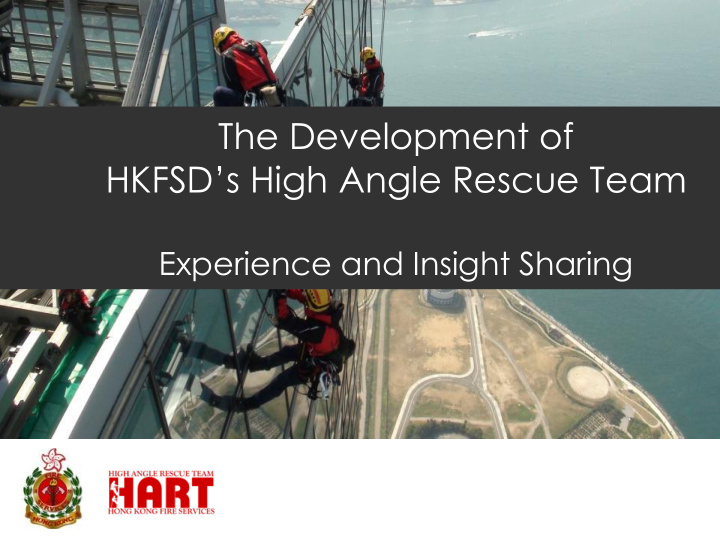



The Development of HKFSD’s High Angle Rescue Team Experience and Insight Sharing
Swiss Army Knife vs Multitool
Traditional High Angle Rescue Use techniques and equipment derived from Mountain Rescue
High Angle Rescue in Modern City Rapid vertical growth in major cities High-rise building related rescue
High Angle Rescue in Modern City Construction-related rescue
High Angle Rescue in Modern City Cable Car Rescue
High Angle Rescue in Modern City Evacuation from Super High-rise Building
High Angle Rescue in Hong Kong Suicide attempt – Jumping off from building / bridge Tower crane rescue Scaffolding rescue Gondola rescue Mountain Rescue
Traditional Rescue Technique Traditional high angle rescue techniques derived from mountain rescue cannot catch up with the rescue needs in modern cities What is missing: suitable standard 、 system 、 efficiency
Traditional Rescue Technique
Traditional Rescue Technique
Change in Rescue Tight time-constraint (Public Expectation) Pressure from Social Network / Internet Media
Rescue Team Focused effort Specialized and Professionalize
International Standard and Technology Based on industrial rope access standard and technique (Industrial Rope Access Trade Association)
International Standard and Technology Combined with rescue standard (National Fire Protection Association)
International Standard and Technology Benefit: keep up with the latest improvement in the field
Classification of Skill Basic Training Advance Training Specialized Training
Effective Allocation of Training Resources Different level of training for different level of rescuers To cater for different incidents and tasks Dispatched according to the nature of incident
High Angle Rescue Team ( HART ) From operational personnel through strict selection process
High Angle Rescue Team ( HART ) Safety awareness
High Angle Rescue Team ( HART ) Team spirit
High Angle Rescue Team ( HART ) Physically fit, suitable mindset for operation at height
High Angle Rescue Team ( HART ) Able to make independent decision, deal with changing environment well
Initial Training for HART Two weeks IRATA basic skill training
Initial Training for HART Three weeks scenario- based on-site training
Continuous Training for HART Consolidate rescue skills through continuous training Members who cannot maintain their skill levels will be replaced
Continuous Training for HART Minimum 80 hours on-rope training every year Focused on on-site training Complemented with refreshment training on basic skills
Continuous Training for HART During on-site training, team members will formulate action plan to practice problem solving and leadership skills
Cable Car Rescue NP 360 Ocean Park
Cable Car Rescue
Tower Crane Rescue
Tower Crane Rescue
Container Terminals Rescue
Bridge Tower Rescue
Drainage Tunnel Rescue
Amusement Facilities Rescue
Support Team Arrangement of HART Consists of instructors from Fire and Ambulance Services Academy with advanced skills Attend high angle rescue incident
Support Team Arrangement of HART High Angle Rescue Incident HART Support HART Leader HART Ops Team 1 Team ) HART Support HART Ops Team 2 Team 2
Support Team Arrangement of HART Provide technical support Ensure operational safety and quality
Support Team Arrangement of HART Use observations from real incidents to enhance future training
Support Team Arrangement of HART Focused effort to ⚫ bring in new equipment; ⚫ refine rescue technique and strategy
High Angle Rescue Cases
Container Terminals Rescue Incident in Dec 2011 Exercise in Sept 2011
Gondola Rescue
Gondola Rescue
Mountain Rescue Two injured hikers trapped at a cliff during Typhoon Pakhar
Mountain Rescue
Mountain Rescue
Mountain Rescue
Mountain Rescue
Summary Specialized, Modernized, Professionalized
Train Hard Fight Easy
Thank you
Recommend
More recommend